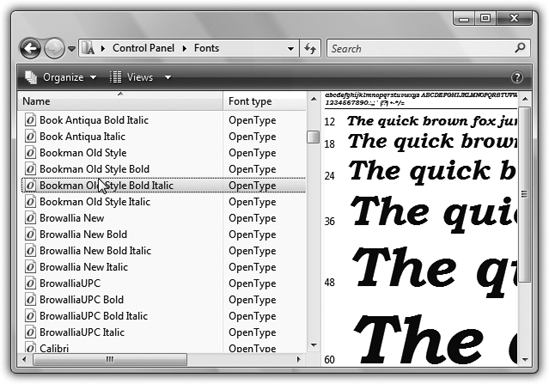Fonts
Some extremely sophisticated programming has gone into the typefaces that are listed in the Fonts dialog boxes of your word processor and other programs. They use OpenType and TrueType technology, meaning that no matter what point size you select for these fonts, they look smooth and professional—both on the screen and when you print.
Managing Your Fonts
Windows comes with several dozen great-looking fonts: Arial, Book Antiqua, Times New Roman, and so on. But the world is filled with additional fonts. You may find them on Web sites or in the catalogs of commercial typeface companies. Sometimes you’ll find new fonts on your system after installing a new program, courtesy of its installer.
To review the files that represent your typefaces, open the Fonts icon in the Control Panel. As Figure 11-6 illustrates, it’s easy and enlightening to explore this folder.

Figure 11-6. All of your fonts sit in the Fonts folder. You’ll frequently find an independent font file for each style of a font: bold, italic, bold italic, and so on. Click a font’s name to see how it looks at various sizes. Double-click a font’s icon to open that preview into a window of its own.
To remove a font from your system, drag its file icon out of this window, right-click it and then choose Delete from the shortcut menu, or highlight it and then choose File→Delete. To install a new font, drag its file icon into this ...
Get Windows Vista Annoyances now with the O’Reilly learning platform.
O’Reilly members experience books, live events, courses curated by job role, and more from O’Reilly and nearly 200 top publishers.

